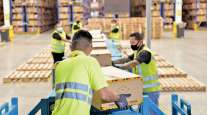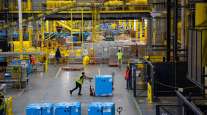Special to Transport Topics
Industry Takes Fresh Look at Reverse Logistics

[Stay on top of transportation news: Get TTNews in your inbox.]
Reverse logistics — the management and movement of returned goods — is one of the most significant systems in the economy, as it affects people and businesses in myriad ways, for example, post-holiday season when a high volume of gift returns are common. However, the returns journey, from purchase to receipt, is a complicated process.
Tony Sciarrotta, Reverse Logistics Association executive director, said the transportation aspect is vital since every touch point is a cost factor. “In the reverse logistics world, returns go through 3-4 times as many touch points as forward goods,” he explained.
Carlton Farr II, vice president of supply chain transportation with Radial Inc., noted reverse logistics’ role in the overall supply chain impacts costs and brand image, plus customer experience and loyalty.
“It can be costly for businesses along the various functions of the supply chain: They generally require double the transportation and staffing costs, as well as additional warehousing space to hold inventory,” he said. “From a business perspective, consumers may not exchange products or repurchase after making a return, so this can also eat into profit margins.”

UPS expects its Happy Returns acquisition to make the returns process more seamless and environmentally friendly. (UPS Inc.)
Radial, an e-commerce fulfillment company, conducted a survey of more than 1,000 U.S. consumers. Farr reported that nearly three-fifths of retail leaders noted the biggest challenges within reverse logistics were the cost of repackaging and restocking (60%) and returned inventory that can’t be exchanged (60%). Retail executives also cited major difficulties with maintaining profit margins (43%), customers returning too much inventory without exchanging it (39%) and limited warehouse or storage space (14%). “These challenges involve increased costs of transportation, labor and warehouse space to accommodate the influx of returns we’ve seen since the onset of the pandemic,” he said.
At the end of 2023, the National Retail Federation reported that total merchandise returns for the retail industry were $743 billion, representing a total return rate of 14.5%. The report noted, “For every $1 billion in sales, the average retailer incurs $145 million in merchandise returns. Online sales do see a higher return rate, with 17.6% or $247 billion of merchandise purchased online returned. That compares to 10.02% for pure brick-and-mortar returns (excluding online orders that are returned in-store), or $371 billion.”
Reverse Logistics Challenges
When comparing forward to reverse logistics, the differences are apparent, said Scot Case, NRF vice president of corporate social responsibility and sustainability.

Case
“When you think about forward logistics, you’re shipping goods to a store, all in uniform-sized boxes, but when items are returned, they have to be separated, sorted and handled in some way, and pallets could be filled with a mix of products that are not packed efficiently,” he explained. “You could be spending large sums of money to bring back low-value products.”
The impact of COVID exacerbated these challenges, said Sciarrotta. With the increase in e-commerce, returns went through the roof, especially as many return policies were relaxed. “Shopping online went on steroids,” he noted adding that online shopping has 3-4 times the return rates of a brick-and-mortar store.
It is especially the case in apparel. Approximately 25% of online apparel purchases are returned, as sizes are not always uniform, and colors may not match what the computer screen displays.

Armstrong
“E-commerce definitely created a problem with returns,” said Satish Jindel, a transportation and logistics consultant with SJ Consulting, noting that one of the problems is when retailers offer free returns, as that can be abused. “What you get back may not get resold at list price but may be sold at a greater discount; there are a lot of costs associated with having to take returns. It has to be managed and controlled or retailers will continue to bear the expenses of it.”
Evan Armstrong, CEO of Armstrong and Associates, a third-party logistics consultancy, described the reverse logistics industry as a fragmented puzzle. “There is a whole inspection process that happens once items are returned. If it’s in good shape, it goes back into inventory for resale,” he said, adding that another challenge is trying to consolidate the supply chain to reduce multiple small-package shipments, which drives up overall costs.
Despite the mad returns rush during COVID, Jindel believes that was a temporary phase, as many people have returned to in-person shopping, which will alleviate some of the logistics issues surrounding returns.
Still, while e-commerce sales have stabilized as compared to the pre-pandemic era, they remain strong, with a 7.8% year-over-year increase between the third quarter of 2022 and the third quarter of 2023, according to Farr’s estimates.
Streamlining the Process
Many retailers do outsource e-commerce returns management to 3PLs, Farr explained.
“Working with a 3PL also provides better operational management and execution, often at a lower cost compared to managing directly because 3PLs have the technology and industry know-how, having specialized in this complicated ecosystem,” he said, adding that one way to reduce and streamline returns is by collaborating with brands to set return policies. “This can include recommending time frames on acceptable return periods, limiting the categories and condition of returnable items and collecting data on returns to capture why products are being returned.”
Armstrong added that a returns processing center operation combined with an outbound center fulfillment operation as well as offering customers advanced exchanges would help fleets better streamline the process. “It helps so you don’t have to get the actual product back before you provide a customer with a replacement,” he said. “It gives you more time to consolidate those parcel shipments in a less costly mode.”

Sciarrotta
It is also a good opportunity for fleets to lend their services and expertise, delivering products as well as picking up returns. Some trucking companies are trying to become refurbishment or return centers for their clients to help cut transportations costs. “Transportation companies need to recognize that they must not be just one step to help the process but the step to help manufacturers and retailers,” said Sciarrotta.
UPS, which ranks No. 1 on the Transport Topics Top 100 list of the largest for-hire carriers in North America, has invested in the reverse logistics market, recently acquiring a reverse logistics software company called Happy Returns. In a press release, the company explained that “users can access a returns portal, make a box-free return at the most convenient location and have their item shipped, sorted and returned to the merchant.” The fleet hopes to leverage the software company’s 800-plus merchant customers in light of the exponential increase in online shopping, which inevitably leads to an increase in returns.

McKinnie
The explosion of e-commerce demand has made reverse logistics a key focus for UPS over the last several years. “The returns market is currently valued at $6 billion and growing. In the weeks following the holiday season, we anticipate 2.7 million returns in our network on any given day,” said Joe McKinnie, UPS director of product management.
Currently, UPS offers 60,000 access point locations where customers can drop off a package. The Atlanta-based fleet expects the Happy Returns acquisition to make the returns process more seamless and environmentally friendly.
“Easier returns help our customers while delivering equally important gains for UPS operations by driving pickup and delivery density. This gives UPS the ability to run the most efficient network in the world while creating less waste and fewer carbon emissions. For example, with Happy Returns, items are consolidated and shipped in reusable totes, which helps reduce emissions and cardboard waste,” said McKinnie.
Future of Reverse Logistics/Solutions
RLA’s Sciarrotta said that the keys to the future are twofold: slowing down returns, and finding more efficient ways to process them.

Farr
On the transportation side of things, the backward movement of goods has created significant growth opportunities for the industry. No matter what goes on behind the scenes at a retailer — whether goods are recycled or refurbished or resold — one thing is clear: The transportation sector saw huge growth. “When you talk about the big trucking companies, they have become more than just transportation companies,” he said. “They are also trying to be refurbishment or return centers for their partners and clients so that they can do that work and cut down on the transportation costs.”
He added that hyperlocal returns — allowing consumers to return items bought online to a local warehouse — creates efficiencies, as manufacturers can then decide what to do with the item. “It is more efficient to be hyperlocal and get someone to check the product out and do something with it,” Sciarrotta said. “That is the circular economy in action, and the transportation sector needs to be more a part of that.”
Advances in AI are also on the horizon, helping customers to make more informed purchases the first time around, such as more optimized product descriptions and images. When it comes to apparel, Farr said, “Brands are also introducing features to support virtual try-ons that allow consumers to get a feel for what the product looks like before it shows up on their doorstep.”
He added that AI-optimized recommendations factor in a consumer’s buying history and preferences to steer them toward products that may be a better match.
Want more news? Listen to today's daily briefing above or go here for more info
AI technology will also be at the center of returns automation in the next 3-5 years, along with more adoption of self-serve returns portals. In that time, Armstrong said, the process of reverse logistics will become more refined and it will become more focused on an environmental, social and governance framework..
“Sustainability will be a continued focus across the board but particularly among return processes,” agreed Farr. “As a result, logistics providers will increase investment of Returns Management Software to drive operational efficiency and enhance returns reporting and data analytics, which boosts the bottom line and contributes positively to environmentally friendly initiatives.”




